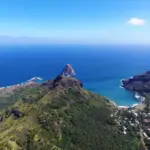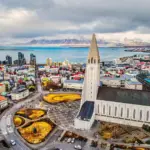A Geographical and Historical Portrait

The Geographical Location of the Cook Islands
Cook Islands, located in the beautiful South Pacific, The Cook Islands are an archipelago made up of 15 volcanic islands and coral reefs. More specifically, these islands are located between Tahiti and New Zealand., covering an impressive geographical area.
The archipelago is divided into two main groups: the Northern Islands, which include Aitutaki and Rarotonga; and the Southern Islands, home to Atiu, Mangaia, and Mauke. Each of these islands has unique characteristics that make them fascinating destinations to explore.
The Historical Context of the Cook Islands
The Cook Islands have a rich history dating back to the earliest Polynesian settlements in the region. The first inhabitants arrived on the islands around 1500 BC, bringing with them their distinct cultural traditions. In the late 18th century, British explorer Captain James Cook first sighted these lands during his exploration of the South Pacific region.
From that meeting history with the explorer, the archipelago acquired its current name. Subsequently, it was subjected to colonial influences from countries such as Spain and France before becoming a British protectorate in 1888.
The Cultural Importance of the Cook Islands
The Cook Islands are home to a vibrant and rich culture, deeply rooted in Polynesian traditions. The Maori language is widely spoken, and the cultural heritage is preserved through dance, music, and crafts. The Cook Islands are known as a warm, welcoming, and hospitable people who take immense pride in their culture.
Traditional art of the Cook Islands is famous for its intricate tattoos, hand-carved wood sculptures, and colorful fabrics made from natural fibers. These cultural elements play a significant role in the identity of the Cook Islands people and provide visitors with a unique experience exploring this incredible South Pacific destination.
These three elements—geographic location, historical context, and cultural significance—form the foundation for understanding the enchantment of the Cook Islands. By exploring these paradisiacal islands, immerse yourself in fascinating history of the archipelago and immerse yourself in the rich culture Polynesia, visitors have the opportunity to experience a unique experience in the heart of the South Pacific.
Discovering the natural beauty of the Cook Islands
Stunning Landscapes: Tropical Paradise on Dry Land
The Cook Islands are truly a treasure trove of stunning landscapes. With their white-sand beaches and crystal-clear waters, it's hard not to fall in love with their captivating beauty. As you stroll along these beaches, you'll be enveloped by a sense of serenity, with the gentle sound of waves crashing against the shore and palm trees swaying in the breeze.
One of the most famous beaches is Muri Beach, with its calm, shallow waters, perfect for swimming or snorkeling. Aroa Beach offers a more secluded and romantic atmosphere, with a spectacular sunset that paints the sky in golden and orange hues.
Besides their idyllic beaches, the Cook Islands are also known for their stunning coral reefs. Vibrant marine life finds refuge in these wonderful ecosystems, offering visitors the unique opportunity to explore them through diving or snorkeling.
The reefs are true natural wonders, colored by a rich variety of corals in vibrant hues like red, yellow, and pink. Tropical fish in every imaginable color swim gracefully among the corals, creating a fascinating and unforgettable visual spectacle.

Exploring the rich marine and terrestrial biodiversity
The Cook Islands are a nature lover's paradise, offering incredible biodiversity both on land and at sea. Their lush mountains, covered in dense tropical forests, invite you to enjoy exciting hikes and treks. island of RarotongaFor example, the Te Rua Manga (The Needle) trail takes you to a peak with stunning panoramic views of the entire island. As you hike the mountain trails, you'll marvel at the diverse flora, including native species such as orchids and koka trees.
The Cook Islands' natural wealth also extends to the underwater world. With its crystal-clear waters and healthy coral reefs, diving in the Cook Islands is a unique experience.
You'll have the opportunity to swim alongside majestic sea turtles, admire rays gliding gracefully through the turquoise ocean, and discover schools of colorful fish that look like they've come straight from a living aquarium. Plus, there's the thrilling chance to spot dolphins frolicking freely in the calm waters surrounding the islands. The natural beauty of the Cook Islands is simply breathtaking—a harmonious blend of idyllic beaches and lush mountainous landscapes, where marine and terrestrial life coexist in perfect harmony.
It's a magical place that offers visitors the opportunity to connect with nature in its purest, most untouched form. There's no doubt that exploring the natural wonders of the Cook Islands is an enriching experience that will leave lasting memories for those who embark on this journey.
Uncovering Cookian Culture
The Polynesian culture of the Cook Islands is a fascinating and unique treasure, offering a wealth of traditions that enchant visitors from around the world. One of the most distinctive characteristics of this culture is its artistic expression through traditional dances, music, and crafts.
Traditional Cook Islands dances, known as "ura" or "tamure," involve graceful movements of the hips and arms, accompanied by vibrant drum and ukulele rhythms. Music also plays an essential role in Cook Islands culture, with harmonious songs that portray stories of daily life on the islands.
Traditional musical instruments include the “pu” (conch-blown shell), the “te reo” (flute), and the Hawaiian guitar. Additionally, local artisans skillfully produce carved wood sculptures, intricate basketwork made from pandanus leaves, and paintings inspired by the islands' stunning landscapes.

Exploring Local Cuisine
An essential part of immersing yourself in Cook Island culture is sampling the unique culinary diversity the Cook Islands have to offer. A popular and emblematic dish is “ika mata”, a delicacy made with raw fish marinated in fresh citrus juice and coconut milk, seasoned with local herbs and spices.
The combination of fresh and spicy flavors makes this culinary specialty a unique experience for the palate. Another traditional way of cooking in the Cook Islands is through the "umu" method, an underground cooking process that uses hot stones to roast food.
Umu is a family celebration where meats, vegetables, and fruits are wrapped in banana leaves and placed in a hole dug in the ground, along with heated stones. After several hours, the food emerges succulent and flavorful, full of the smoky aromas characteristic of this ancient cooking method.
Rarotonga: The Jewel of the Cook Islands
The incomparable beauty of its stunning beaches
Rarotonga, the largest island in the Cook Islands archipelago, is a true tropical paradise. Its beaches are simply stunning and offer visitors an experience unique and unforgettable.
With soft white sands bathed by the crystal-clear waters of the Pacific Ocean, you'll be captivated by the serenity and tranquility these paradisiacal locations offer. Whether relaxing on a lounge chair under the shade of coconut trees gently swaying in the breeze or diving into the warm, clear waters, Rarotonga's beaches are an irresistible invitation to peace and well-being.
Exploring the scenic hiking trails
Besides its magnificent beaches, Rarotonga is also known for its scenic trails, offering spectacular views of the island. Nature lovers will delight in the hiking options available, each offering a different perspective of the lush tropical landscape. One of the most popular trails is the Cross Island Track, which traverses dense forests to reach Te Rua Manga, also known as The Needle—an iconic rock formation offering stunning panoramic views of the island.
Another stunning trail is the Muri Beach Track, which runs along the coast and offers incredible views of the coastline and turquoise waters. If you're a watersports enthusiast, the Wigmore's Waterfall Trail is a must-do, leading to a beautiful waterfall surrounded by lush vegetation.
how to get to the cook islands
To reach the Cook Islands, there are several flight options departing from different countries. The main airlines flying to the Cook Islands are Air New Zealand, Air Tahiti, and Virgin Australia.
Below is some information on how to get to the Cook Islands from different locations:
- From Brazil: The most common way to get to the Cook Islands from Brazil is by flights departing from Sao Paulo or Rio de Janeiro with a connection in Auckland, in New Zealand.
- From Portugal: The most common way to get to the Cook Islands from Portugal is via flights departing from Lisbon with a connection in Auckland, New Zealand.
- Other countries: The Cook Islands can be reached by flights from various countries, such as Australia and New Zealand. It's important to check the flight options available from your country of origin and the connections required to reach the Cook Islands.
It's important to remember that flight and connection information may vary depending on the time of year and airline availability. It's recommended to check flight options and schedules directly with airlines or travel agencies.
Conclusion
Rarotonga is truly the jewel of the Cook IslandsWith its stunning beaches that mesmerize visitors with their unparalleled natural beauty and its scenic hiking trails that provide breathtaking views of the island, this Polynesian island captivates the hearts of those privileged to visit.
Furthermore, the rich Cookian culture blends harmoniously with natural wonders of Rarotonga, making it a complete and enriching experience for all travelers. If you are looking for a paradise destination where you can relax on pristine beaches or explore magnificent landscapes through exhilarating hikes, Rarotonga is the perfect place to quench your thirst for adventure and stunning beauty.
Lucas Wanderlust has a tireless spirit of adventure, always seeking new travel experiences. Fascinated by the world and the possibility of exploring unknown destinations, he fell in love with the sense of freedom and self-discovery that traveling alone provides. With a backpack on his back and a heart open to the unknown, Lucas embarks on exciting journeys, where each destination becomes a unique chapter in his life story. He gives himself body and soul to the magic of solo travel, inspiring others to follow in his footsteps and discover themselves through adventure.







